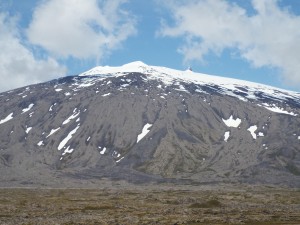Under the Glacier is a short and typically strange novel by the Icelandic Nobel laureate Halldór Laxness. It’s narrated in the first person by a young man sent as an emissary by the Bishop of Iceland (‘Embi’) to investigate the theological irregularities of a small community living under the Snæfellsjökull glacier, out at the end of the Snæfellsnes peninsula in the west of the island. (I was particularly interested to read the novel because we visited Snæfellsnes this summer, when the photo above of Snæfellsjökull was taken.) Embi meets the backsliding pastor Jón Prímus and various other local oddballs, none of whom are interested in Christianity – rather, they plan to retrieve some sort of coffin from the glacier in order to perform a resurrection.
The premise of the book is strikingly similar to that of Flying to Nowhere, John Fuller’s grotesque novella that opens with a horse being fatally injured as it disembarks a boat. Fuller’s book isn’t without a certain dark humour, but in tone the two books are otherwise completely different. Laxness’s characters are sarcastic yokels who make light of the emissary’s metropolitan earnestness, and the whole book is infused with a knockabout tone which continually undermines any attempt to take the story or its events seriously. It’s largely a series of dialogues at cross-purposes, with Embi trying to get to the bottom of weighty matters and his interviewees simply chatting or spouting a New-Age mumbo-jumbo that draws on science, Buddhism, Existentialism and whatever else Laxness happens to chuck in. Interspersed with the dialogues are a few lyrical vignettes of provincial Icelandic life in the 1960s.
The narrative continually switches between past and present tenses – I’m told that Icelandic literature is very given to the historical present, and I have a suspicion that when I read translations of the family sagas, much of that switching has been silently edited out. If that’s the case, then on the whole I’m grateful, as it makes for an odd reading experience to an English-speaking reader who isn’t used to the extent it’s used here.
Taken as a whole the book barely hangs together, hardly bothers to in fact. The ending is a case in point, a half-hearted flourish which gestures at aesthetic unity without really delivering. But the central narrative, a bureaucratic investigation of the great mysteries of existence by a callow youth, is hardly one which offers a satisfying arc. Instead, there are really wonderful ideas, sentences, jokes and exchanges which begin as fruits gathered along the way but end as the reader’s main concern: more and more I found that reading Under the Glacier became an act of gathering a succession of these brilliant atoms, which together formed a kind of casual heap that shed light on the world.
This impression was magnified by contrast when the next book I picked up was The Story of a New Name, the second book in Elena Ferrante’s Neapolitan sequence. Ferrante’s writing doesn’t lack fine phrases; but they aren’t its purpose. Narrative in a traditional sense is what Ferrante offers, so skilfully represented that events that could have been drawn from a particularly dull soap opera become both clear and compelling. I don’t want to put her books down (I simply don’t put them down; I go on reading) – whereas reading Laxness is always slightly laborious, because in spite of the comedy, the pace and the grace of his writing, his refusal to move a story on presents a constant challenge to the reader: What are you reading for? What do you think a book can give you?

One thought on “Under the Glacier”